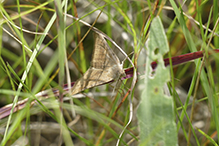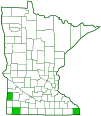Small mocis
(Mocis latipes)
Conservation • Description • Habitat • Ecology • Distribution • Taxonomy
|
|
||||||||||||||||||
Description |
Small mocis is a medium-sized moth. The adult is ¾″ to ⅞″ long and has a wingspan of 1 5 ⁄16″ to 1 11 ⁄16″. The drab, yellowish-brown and brown coloration helps to conceal it in dead grass. The forewing is yellowish-brown with brown lines and spots. The lower median area, and a band beyond the postmedial line, are brown. A nearly straight line (antemedial line, AM line) separates the basal and median areas. Another nearly straight line (postmedial line) separates the median area and the postmedial area. In the lower median area there is a kidney-shaped spot (reniform spot) with a dark center. A small spot between the reniform spot and the inner margin (subreniform spot) is round, outlined in black, and hollow. The two spots are almost fused together. There is sometimes a small black spot along the inner margin at the AM line. The hindwings are yellowish-brown with dark brown shading in the antemedial and marginal areas, and a poorly defined, pale, oblique line. The larva is called striped grass looper |
Size |
Total length: ¾″ to ⅞″ Wingspan: 1 5 ⁄16″ to 1 11 ⁄16″ |
Similar Species |
Habitat |
Grasslands, agricultural fields |
Ecology |
Season |
Multiple generations per year: June to October |
Behavior |
Adults are active at night and will come to lights. At rest, the wings are held flat, and the moth forms almost an equilateral triangle in outline. Caterpillars drop to the ground when threatened. |
Life Cycle |
|
Larva Hosts |
Mostly various grasses, including rice and corn; also beans and turnip |
Adult Food |
|
Distribution |
||
|
Sources |
|
| 8/18/2025 | ||
Occurrence |
||
Common in southeast and Midwest United States. Uncommon in Minnesota |
||
Taxonomy |
|
Order |
|
Superfamily |
Noctuoidea (Owlet Moths and Allies) |
Family |
Erebidae (Underwing, Tiger, Tussock, and Allied Moths) |
Subfamily |
Erebinae (underwings, zales, and related owlets) |
Tribe |
Euclidiini |
Genus |
Mocis |
Subordinate Taxa |
|
|
|
Synonyms |
|
Mocis collata Mocis delinquens Mocis diffluens Mocis exscindens Mocis indentata Mocis punctata Mocis repandana Mocis repandella Mocis repandoides Mocis subtilis Remigia latipes |
|
Common Names |
|
small mocis small mocis moth striped grassworm looper striped grass looper |
|
Glossary
Antemedial line
A thin line separating the basal area and the median area of the forewing of Lepidoptera.
Reniform spot
A kidney-shaped spot or outline in the lower median area near the PM line on the forewing of many moths.
Visitor Photos |
||
Share your photo of this insect. |
||
This button not working for you? |
||
Laura Baxley |
 |
Mocis latipes |
MinnesotaSeasons.com Photos |
||
|
||
|
||

Slideshows |
Mocis latipes |
About
Xxxxxxxxxxxx |

Visitor Videos |
||
Share your video of this insect. |
||
This button not working for you? |
||
|
Other Videos |
||
Mocis latipes - Small Mocis Moth - curuquerê-dos-capinzais (Euclidiini) |
About
Published on Jul 3, 2015 Mocis latipes - Small Mocis Moth - Striped Grass Looper - curuquerê-dos-capinzais (Lepidoptera - Noctuoidea - Erebidae - Erebinae - Euclidiini) Biodiversidade, Biodiversity, Nature videos, Vídeos de Natureza, Santo Amaro da Imperatriz, Florianópolis, Santa Catarina, Brasil Synonyms: Remigia latipes (Guenée, 1852), Ophiusa delinquens (Walker, 1858), Remigia exscindens (Walker, 1858), Remigia subtilis (Walker, 1858), Remigia collata (Walker, 1865), Remigia indentata (Harvey, 1875) It is found from North America (from southern Ontario and Quebec to Florida, west to Arizona, north to Minnesota and south through Central to South America. The forewings are yellowish brown variably shaded with darker brown. Females are more yellowish to reddish than the males. The hindwings are yellowish brown with dark brown shading and two faint lines. Adults are on wing from June to October. The larvae feed on various grasses, including rice and corn. They have also been recorded feeding on beans and turnip. Thanks to Noe Avila for id in taxonomy help original videos filmings, 3D modelings, arts animations created and directed by Diego da Cruz Pereira © DiegoDCvids |
grass looper, small mocis |
About
Published on Feb 4, 2018 |
Mariposas Letis buteo e Mocis latipes |
About
Published on Jul 16, 2017 |
gusano medidor (Mocis latipes) |
About
Published on Jun 30, 2012 |

Created: 7/24/2018 Last Updated: © MinnesotaSeasons.com. All rights reserved. |


